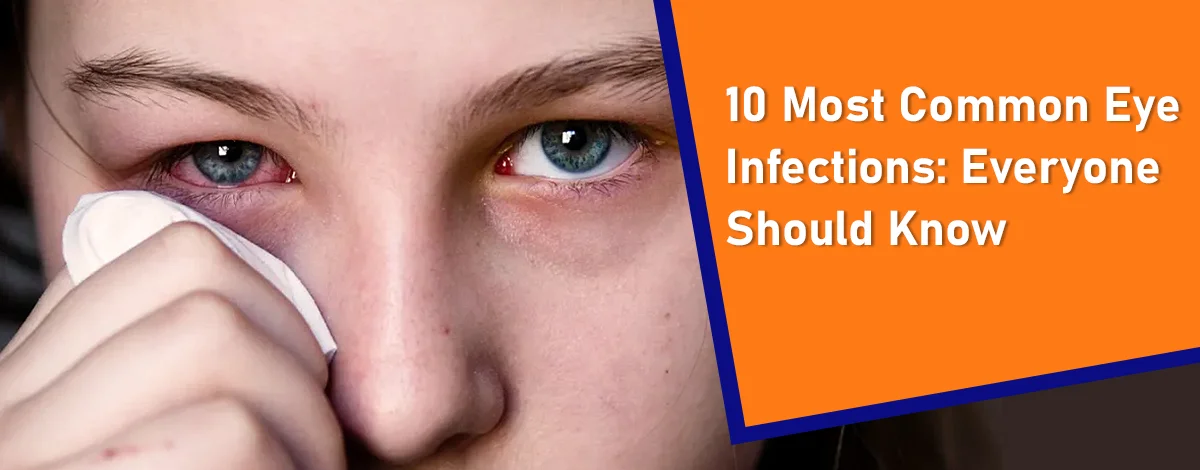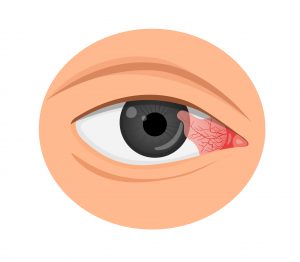
10 Most Common Eye Infections Which Spread Generally
When a normal, regular guy catches an eye infection, normally they don’t know if it’s a serious infection or a basic eye infection, and this time they will definitely be foled by some doctors, so it’s important to have the basic information about the most common eye infections. For that, we are sharing details about the most common eye infections. Infections of the eyes can result in swelling, discharge, and pain. However, the cause—viral, bacterial, or fungal—determines the symptoms and available treatments. At Barman Eye Care Centre, we treat common eye infections or diseases such as dry eye, pink eye, refractive, and many more with the help of the best eye specialist doctors.
Basic Eye Infections

You probably have an eye infection if you’ve observed any discomfort, swelling, itching, or redness in your eyes. Depending on what causes them, eye infections can be classified as viral, bacterial, or fungal, and each requires a separate course of treatment.
The good news is that you can get treatment quickly because eye infections are easy to identify.
This information is required to identify the cause and treat the eight most prevalent eye infections.
1. Conjunctivitis/Pink Eye
Among the most frequent illnesses of the eyes is infectious conjunctivitis, sometimes known as pink eye. It occurs when bacteria or a virus infect the blood vessels in the conjunctiva, the fragile membrane surrounding your eyeball.
Your eyes consequently become irritated and turn pink or red.
Allergies or exposure to chemicals, such as chlorine in swimming pools, can also cause it.
It is widespread for viruses or bacteria to produce conjunctivitis. For up to two weeks from the onset of the infection, you can still spread it. If you have any of the following symptoms, get in touch with your doctor right away so they can be treated:
- Hue to your eyes, either pink or reddish
- Itching or a feeling that something is always in your eyes, causing more tears than usual, especially in one eye, might yield a watery discharge from your eyes that is thickest when you wake up.
2. Keratitis
Infection of the cornea results in infectious keratitis. The transparent layer covering your iris and pupil is called the cornea. An eye injury or an infection (bacterial, viral, fungal, or parasitic) can cause keratitis. Keratitis, which is defined as corneal swelling, is not necessarily communicable.
Keratitis symptoms can include:
- redness and swelling in the eyes, pain or discomfort in the eyes, abnormal discharge or more tears than usual, and pain or discomfort when you open and close your eyelids
- partial vision loss or hazy eyesight
- light sensitivity, feeling as if something were lodged in your eye
Keratitis is more likely to occur if:
- You have contacts.
- You live in a warm, humid climate; you take corticosteroid eyedrops for an eye disease; your immune system is compromised due to another sickness or condition;
- Plants that contain compounds that can enter your eyes cause damage to your eyes.
· If you experience any signs of keratitis, see your doctor so the infection can be stopped
3. Endophthalmitis
Severe inflammation of the internal eye tissue caused by a fungal or bacterial infection is known as endophthalmitis. Fungal infections caused by Candida most commonly cause endophthalmitis.
Although uncommon, this ailment can develop following specific eye procedures, such as cataract surgery. It could also occur if something pierces your eye. Symptoms to be aware of include the following, particularly following surgery or an eye injury:
- Mild to severe pain in the eyes
- partial or total loss of vision
- hazy vision
- inflammation or redness around the eyes and lids, discharge or pus in the eyes, and sensitivity to bright lighting
4. Blepharitis
An inflammation of the skin folds protecting your eyes is called blepharitis. The most common cause of this kind of irritation is blockage of the oil glands beneath the skin of your eyelids, at the base of your lashes. Bacteria may be the cause of blepharitis.
Blepharitis symptoms include:
- redness, itching, edema, or oiliness of the eye or eyelid
- searing feeling in your eyes and the impression that something is lodged there
- more tears than usual due to light sensitivity crustiness around your eyes or on your lashes
Blepharitis is more likely to strike if you:
- Have dandruff on your scalp or brow, are allergic to makeup on your eyes or face, or have malfunctioning oil glands
- Having mites or lice on your lashes
· Take certain drugs that have an impact on your immune system
5. Sty
An oil gland on the outer corners of your eyelids gives rise to a pimple-like protrusion known as a sty (also termed a hordeolum). These glands may become blocked with debris, oils, and dead skin, promoting the overgrowth of bacteria. A sty is the resultant infection.
Among the signs of sty:
- Anguish or sensitivity
- Crassness around your eyelids increased tear production, itching or discomfort, swelling, and increased tear production
6. Uveitis
When an infection causes your uvea to become inflamed, you get uveitis. The retina is the portion of your eye that sends images to your brain, and the uvea is the inner layer of your eyeball that carries blood there.
Viral infections, eye trauma, and immune system disorders are common causes of uveitis. Most uveitis cases are not life-threatening, but if a severe case is left untreated, blindness may result.
Symptoms of uveitis may include:
- redness in the eyes, pain, “floaters” in your field of vision, sensitivity to light, and hazy vision
7. Cellulitis
Infection of the eye tissues results in eyelid cellulitis, also known as periorbital cellulitis. It is frequently brought on by bacterial infections of neighboring structures, such as sinus infections, or injuries like scratches to the tissues of your eyes that allow the introduction of pathogenic bacteria like Staphylococcus (staph).
Because of the type of bacteria that causes cellulitis, young children are more susceptible to infection and are, therefore, more prone to getting cellulitis.
In addition to skin swelling around the eyes, cellulitis can cause redness and swelling on the eyelids. Usually, you won’t have any eye pain or discomfort.
hazy vision
8. Ocular herpes
When the herpes simplex virus (HSV-1) infects your eye, it can cause ocular herpes. It’s commonly referred to as eye herpes.
Instead of through sexual contact (that’s HSV-2), contact with an individual who is infected with HSV-1 can transmit eye herpes. One eye at a time tends to be affected by the following symptoms:
Eye pain and irritation, sensitivity to light, fuzzy vision, tears in the cornea or eye tissue, thick, watery discharge, and inflammation of the eyelids are all possible side effects that could go away on their own in a week or two.
9. Corneal Ulcer
A corneal ulcer is a painful and often severe infection that affects the cornea, the clear front surface of your eye. This condition typically occurs due to a bacterial, viral, or fungal infection. Corneal ulcers can lead to severe complications and vision loss if not treated promptly.
Symptoms of a corneal ulcer include:
- Intense eye pain
- Redness and inflammation in the eye
- Excessive tearing
- Sensitivity to light
- Blurred or hazy vision
- White or yellow discharge from the eye
Corneal ulcers can be caused by wearing contact lenses for an extended period, eye injuries, or other underlying eye conditions. If you suspect you have a corneal ulcer, seek a doctor immediately to prevent further complications.
10. Ocular Toxoplasmosis
Ocular toxoplasmosis is an eye infection caused by the parasite Toxoplasma gondii. This parasite can enter your body through contaminated food, water, or contact with infected animals. While toxoplasmosis typically affects the central nervous system, it can also target the eyes, leading to vision problems.
Symptoms of ocular toxoplasmosis may include:
- Blurred or reduced vision
- Eye pain and redness
- Sensitivity towards light
- Floaters or dark spots in your field of vision
Ocular toxoplasmosis can cause long-term damage to your eyes if not treated promptly. Your eye doctor may prescribe medications to manage the infection and prevent further complications. If you suspect you have ocular toxoplasmosis, consult with a healthcare professional as soon as possible.
The final word
The symptoms of an eye infection usually go away in a few days.
But if you have severe symptoms, get emergency care. A trip to the doctor should be prompted by pain or visual loss.
The likelihood of consequences decreases with the early treatment of an infection.
Barman Eye Care Centre is here to treat common eye infections or diseases such as dry eye, pink eye, refractive, and many more with the help of the best eye specialist doctors.

